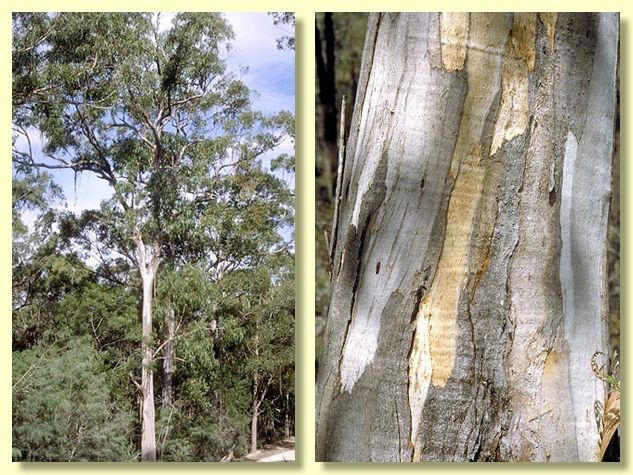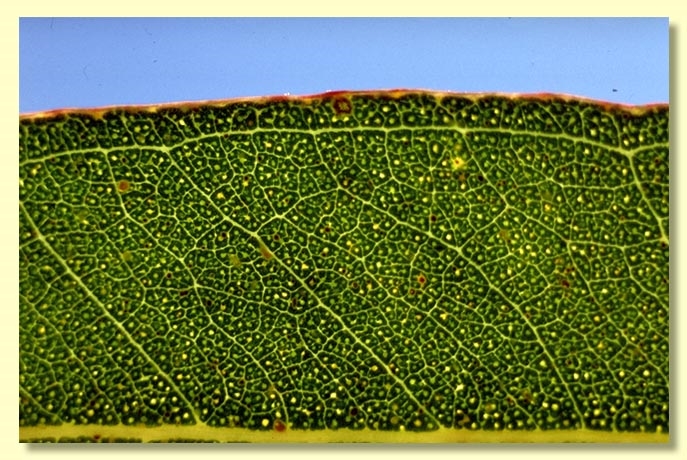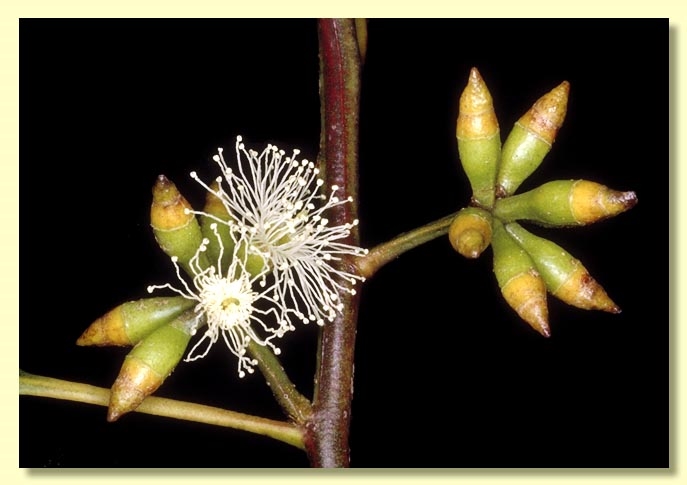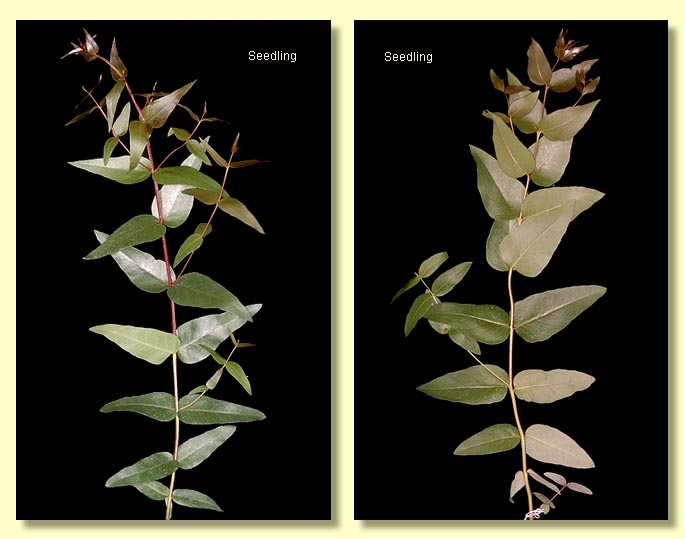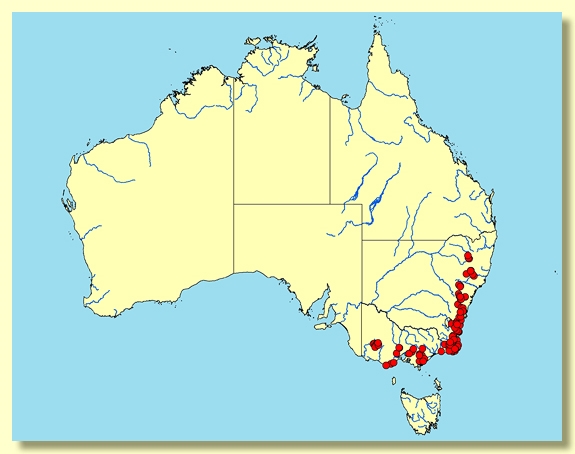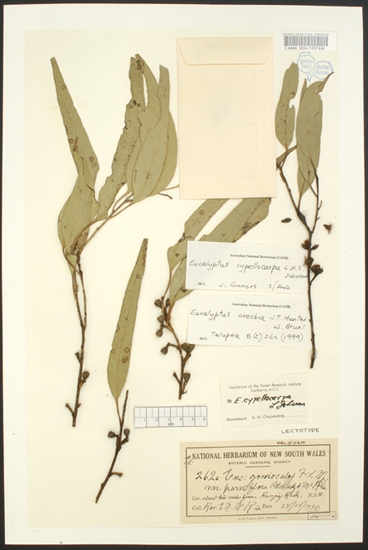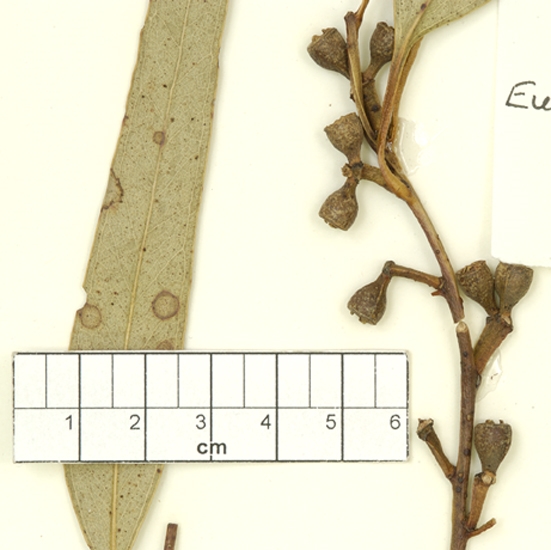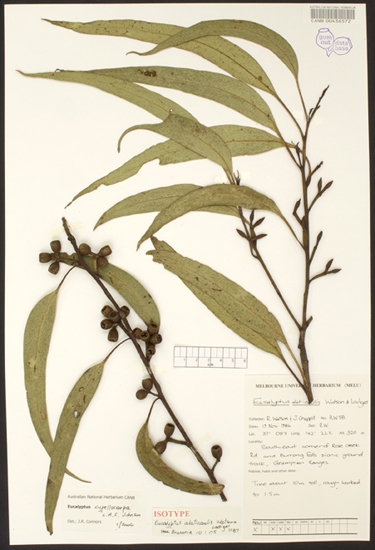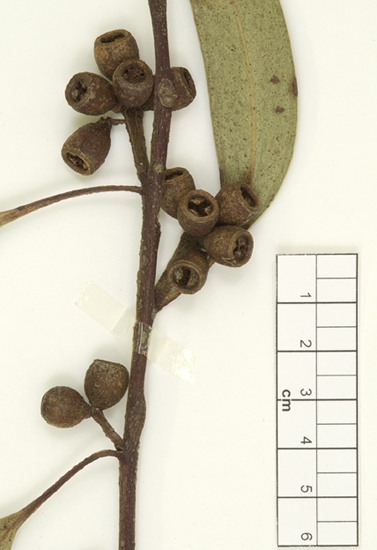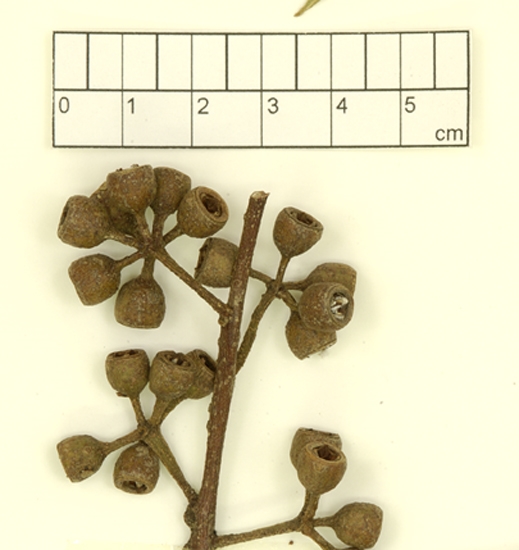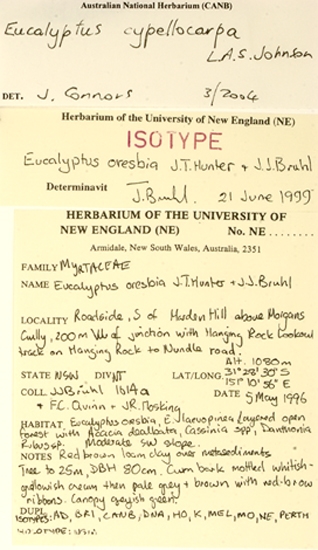Euclid - Online edition
Eucalyptus cypellocarpa
Eucalyptus | Symphyomyrtus | Maidenaria | Euryotae | Globulares | Remanentes
T: Sawmill to Wynnes Rocks, Mt Wilson, NSW, 23 Sept. 1949, L.A.S.Johnson s.n.; holo: NSW.
Eucalyptus goniocalyx var. acuminata Benth., Fl. Austral. 3: 230 (1867). T: Gippsland, Vic., F.Mueller s.n.; holo: K; iso: MEL.
Eucalyptus goniocalyx var. parviflora Blakely & McKie, Proc. Linn. Soc. New South Wales 63: 66 (1938). T: 2 miles from Hanging Rock, NSW, 28 Oct. 1930, E.N.McKie s.n.; lecto: NSW, fide L.A.S.Johnson, loc. cit.; isolecto: CANB, MEL.
Eucalyptus quinniorum J.T.Hunter & J.Bruhl, Telopea 8: 257(1999). T: New South Wales: Northern Tablelands, 'Bornhardtia' property east of Barraba, below Bald Rock, 30° 21' 150° 54', 5 July 1998, J.T.Hunter 8662 & V.H.Hunter; holo: NSW; iso: BRI, CANB, CHSB, MEL, NE, PERTH.
[Eucalyptus goniocalyx auct. non F.Muell. ex Miq.: W.F.Blakely, Key Eucalypts 157 (1934), fide L.A.S.Johnson, loc. cit.]
Bark smooth throughout, yellowish, pale grey, cream or grey-brown or orange-brown, or with some persistent slabs of rough bark or thin rough bark on lower trunk; often with horizontal bark scars on rough or smooth bark, ribbons of decorticated bark sometimes present.
Juvenile growth (coppice or field seedlings to 50 cm): stem square in cross-section and prominently winged, usually not glaucous; juvenile leaves opposite and sessile for many nodes, lanceolate to cordate to ovate, 4.5–12(16) cm long, 1.8–5.5(7.5) cm wide, margin entire or crenulate, base amplexicaul, or lobed or rounded, discolorous, glossy, green, glaucous only on new growing tips, visible wax not persisting as leaves expand.
Adult leaves alternate, petiole 1.2–3.2 cm long; blade lanceolate to falcate, 9–30.5 cm long, 1–4.8 cm wide, flat or undulate (sometimes), base tapering to petiole, concolorous or slightly discolorous, usually glossy, green, side-veins usually at greater than 45° to midrib, moderately to densely reticulate, intramarginal vein parallel to and well removed from margin, oil glands mostly island.
Inflorescence axillary unbranched, peduncle often broadly flattened, 0.8–2.2 cm long, buds 7 per umbel (very rarely 3-budded), sessile or on pedicels to 0.7 cm long. Mature buds oblong to ovoid, 0.8–1.1 cm long, 0.3–0.6 cm wide, green to yellow, usually with slight angles, scar present, operculum conical to beaked, stamens irregularly flexed, anthers cuboid to oblong, versatile, dorsifixed, dehiscing by longitudinal slits (non-confluent), style long, stigma blunt or tapered, locules 3 or 4, the placentae each with 4 vertical ovule rows. Flowers white.
Fruit sessile or with pedicels to 0.6 cm long, usually cylindrical or barrel-shaped, sometimes cup-shaped to hemispherical, 0.5–1 cm long, 0.5–1 cm wide, sometimes slightly angled, disc descending, valves 3 or 4, near rim level or enclosed, rarely slightly exserted.
Seeds black, brown or grey, 1–2.5 mm long, ovoid or flattened-ovoid, often pointed at one end, usually lacunose, dorsal surface smooth or shallowly pitted, hilum ventral.
Cultivated seedlings (measured at ca node 10): cotyledons bilobed; stems usually square in cross-section, sometimes winged also, glaucous or non-glaucous; leaves sessile and opposite for at least 20 nodes, orbicular, cordate or lanceolate, 4–12 cm long, 1.5–7.5 cm wide, usually amplexicaul, sometimes lobed or rounded, discolorous, often glossy green above and glaucous beneath.
Flowering has been recorded in January, March, April, May, June, October and November.
A medium-sized to tall tree widespread from the Central Tablelands of New South Wales, south through the subcoastal ranges and plains, and through the ranges of western, central and eastern Victoria, becoming more disjunct in the west, occurring in the Otway Range, west of Mt Macedon and in the Pyrenees. Trees with smaller stature are found in the Grampians in Victoria and erect mallee and stunted tree forms occur in the species isolated occurrences near Nundle and Kingstown on the Northern Tablelalnds of New South Wales. As a smooth-barked tree Eucalyptus cypellocarpa may be confused with other tall smooth-barked trees in the wetter forests (e.g. E. viminalis). Eucalyptus viminalis subsp. viminalis is distinguished from E. cypellocarpa by having three-budded inflorescences and much narrower juvenile leaves. Another tall smooth-barked tree of the wet forests with seven-budded inflorescences is E. globulus subsp. maidenii. E. cypellocarpa is distinguished from it by having much less prominent juvenile leaves and by the oblong to ovoid, non-warty buds usually with a slight longitudinal angle or rib.
At the north end of the distribution of E. cypellocarpa, two related taxa occur, viz. E. retinens and E. volcanica, which are distinctly rough-barked on the trunk. In Victoria the coastal species E. litoralis from Anglesea and Airys Inlet differs from E. cypellocarpa in having mature buds consistently longer but shows some overlap in size and shape of all other parts. E. litoralis could be regarded as a coarse coastal form of E. cypellocarpa.
Throughout the range of E. cypellocarpa trees with some proportion of retained dead bark (i.e. rough scrappy box-type bark) occur infrequently in mixed stands with trees that shed their bark regularly (i.e. smooth bark). In Victoria trees from the Grampians and Victoria Range often have a proportion of thin rough bark but smooth-barked trees also occur. Watson & Ladiges (1987) described Eucalyptus alaticaulis to accomodate these thinly rough-barked trees in the Grampians and at Anglesea, citing further differences in juvenile leaf shape, wingedness of the seedling stem and the shortness of the pedicel as additional characters. The authors of EUCLID include E. alaticaulis in synonymy with E. cypellocarpa because all these features are variable across the whole geographic range. For the same reason the more recently described E. pyrenea from the Pyrenees Range, Victoria, and E. quinniorum and E. oresbia from the Northern Tablelands of New South Wales, are also included in synonymy.
Eucalyptus cypellocarpa belongs in Eucalyptus subgenus Symphyomyrtus section Maidenaria, a large group of species more or less restricted to south-eastern Australia, characterised by bilobed cotyledons, simple axillary inflorescences, buds with two opercula, stamens with versatile anthers and flattened seeds with a ventral hilum. Within this section, E. cypellocarpa belongs in series Globulares subseries Remanentes, having sessile, juvenile leaves opposite for many pairs on square, more or less winged, stems, small buds in clusters of 7 and small fruit with a descending disc.

